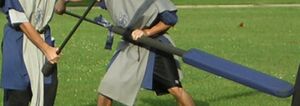Glaive

Overview
A Glaive is a polearm with a striking surface, typically with a stabbing tip as well.
History
A glaive is a polearm consisting of a single-edged blade on the end of a pole. It is similar to the Japanese naginata and the Chinese Guan Dao. However, instead of having a tang like a sword or naginata, the blade is affixed in a socket-shaft configuration similar to an axe head. Typically, the blade was around 45 cm (18 inches) long, on the end of a pole 2 m (6 or 7 feet) long. Occasionally glaive blades were created with a small hook on the reverse side to better catch riders. Such blades are called glaive-guisarmes.
According to the 1599 treatise Paradoxes of Defense by the English gentleman George Silver, the glaive is used in the same general manner as the quarterstaff, half pike, forest bill, halberd, or partisan. Silver rates this class of polearms above all other individual hand-to-hand combat weapons.
Sourced from:[Wikipedia.org]
Within Belegarth, all weapons constructed to resemble a sword mounted on a longer shaft are generally called a glaive. In addition, some members also use the term glaive interchangably with polearm.
Glaive Construction
For instructions on building a glaive, see Constructing a Glaive.
Built on a core of Bandshoppe poles or 1"+ PVC, glaives are usually between 6'-9' in length. Glaives between 4'-6' in length are occasionally called poll-axes (or pole axes).
Typically, 1/3 of the weapon is handle, 1/3 (usually) is incidental padding, and the last 1/3 is a striking surface. Given that the weapon is longer than the 48" minimum of class II weapons, this striking surface counts as Red. With the great leverage a long swung weapon can produce, a thicker striking surface is required than normal.
Glaives in Belegarth
A common weapon, Glaives are often used as alternatives to spears in support of a shield wall. The striking surface gives them a greater versatility, allowing them to also partially overcome the common anti-spear tactic of grabbing behind the stabbing tip.
Due to their mass and extreme length, glaives can be among the most dangerous weapons in Belegarth, particularly when swung hard for a shield-breaking hit. Particular attention must be paid to ensure that glaives are sufficiently padded during construction and weapons check. New fighters are often discouraged from wielding glaives until they are more experienced, and all fighters must exercise extreme caution when swinging in a downward chopping motion. Some discourage this swing from ever being used, though it is frequently one of the few available in a tight line situation.
